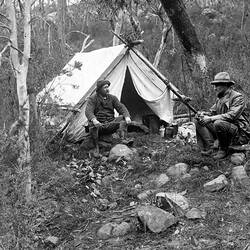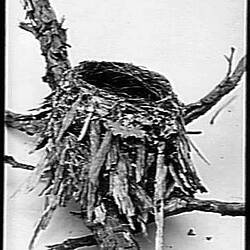YELLOW -BREASTED SHRIKE ROBIN
Eopsaltria Australis, Latham - (175)
Geographical Distribution - South Queensland, New South Wales, Victoria and South Australia.
Nest - Cup-shaped, neat and beautiful in form, constructed of fine twigs, but chiefly bark, with lengthened pieces of outer bark (sometimes two or three inches long) stuck on perpendicularly, outwardly, by means of spiders' web,, and further ornamented, especially about the rim, with lichen; lined inside with a few rootlets and pieces of dead, flat, sword-like grass, or with whole small dead leaves of eucalypts, &c. Usually placed low in the slender fork, or on a horizontal branch of a tree in scrub, by creek or in forest. Dimensions over all, 3-1/2 to 4 inches by 3 inches in depth; egg cavity, 2 to 2-1/2 inches across by 1-1/2 inches deep. (See illustration.)
Eggs - Clutch, two or three; varies in shape from roundish-oval to longish oval; texture of shell fine; surface slightly glossy; colour varies from light greyish-green to bright, bluish-green spotted and blotched, especially about the apex, with reddish-brown or chestnut and dull purplish-grey. Dimensions in inches of a clutch of round examples: (1) .83 x .65, (2) .82 x .65, (3).82 x .62; of a pair of long examples: (1) .94 X .62, (2) .91 X .63. (Plate 12.) A pair taken in Queensland is smaller in size, light apple-green in colour, somewhat faintly spotted all over with yellowish -brown and dull purplish-brown: (1) .78 x .59, (2) .74 x .61.
Observations - Of all feathered forest friends I know of none more attractive than the confiding and shapely Yellow-breasted Shrike Robin (it has become advisable to use the words Shrike Robin because these birds are not truly Robins*). Enter any quiet sylvan nook or deep gully for a while, and there one of these dear birds will surely detect your presence, and, alighting in a pretty attitude on a twig or clinging sideways to the bark of some tree-stem near, will watch your movements. Their lovely nests, too, as forest ornaments, are extremely beautiful.
In the calm autumn evenings, when darkness is coming down upon the forest, it is pleasant to hear the numerous Yellow Shrike Robins in the timber with chirping hisses, unsettled, or rather settling down for the night.
However, the range of habitat and the varieties of the Yellow Shrike Robin of eastern parts are somewhat perplexing to naturalists. The British Museum Catalogue simply bunches them together, but not without certain qualifications in the shape of carefully selected foot-notes.
This interesting Shrike Robin is at home in nearly all parts of Victoria. Extending its habitat northward, it appears to skip the sub-tropical scrubs of the Richmond and Clarence districts, where its place is taken by E. chrysorrhous (E. magnirostris, Ramsay) reappearing in the drier parts of Queensland, notably about the Fitzroy River, where I procured skins in the Brigalow (acacia) scrub.
In Victoria, although the Yellow Shrike Robin especially enjoys the dark dank recesses of the great forest gullies, it may be observed in more open localities, such as in the belts o coastal tea-tree (Leptospermum) near the sea. I have taken its nest in the dry scrub of the Bendigo district, and once saw a pair of these birds in some acacia brush on the lower Murray near Echuca.
Naturally some of the Yellow Shrike Robins exhibit great anxiety when a person approaches a nest with young. They go hopping about with measured pace over the ground, at each hop flattening their bodies, while their pretty yellow breasts cleave to the earth. At intervals the wings are partially extended, and all through the acting is the embodiment of painful despair.
Mr. Hermann Lau's poetical allusions to the Yellow Shrike Robin are, 'It is early morning, just as the dawn is approaching. Lying half awake, half-dreaming, in my lonely tent close behind the palm wold of Cooyer scrub, I hear a fine, equal, oft-repeated note in the thicket, as if heralding the golden sun, and which fills my heart with thankfulness to my great Creator. The notes emanate from this dear little bird, which also sings its psalm of praise to it is Maker at early dawn (Eopsaltria, the bird's generic name, literally means 'Psalm of Dawn').
'The Yellow Shrike Robin builds a nest manufactured out of string-like underbark, lined inside with dry grass and a few withered leaves like those of melaleuca, and usually situated in a three-pronged fork of a small tree. Lays two, rarely three, eggs, and is an early breeder. Cooyer (South Queensland), October, 1833.' It is just possible that Mr. Lau's note may refer to the Yellow-rumped variety (E. chrysorrhous).
Usual breeding months September to December or January. In its more northern habitat in mild winters it is said to commence sometimes as early as June. I had through my hands two clutches of eggs taken in Queensland by Mr. W.B. Barnard in July, 18997. Two and probably three broods are reared in a season. Mr. G. E. Shepherd reports the curious occurrence of a double clutch - six eggs in a nest.
In concluding the observations on the common Yellow Shrike Robin, it may be here remarked that the bird figured in Gould (vol. iii., pl .ii.) is referable to the succeeding species (E. chrysorrhous), which differs from the common species in having the rump of a bright yellow colour, whereas E. australis has the same part dull wax olive. Both sexes are alike except that the male possesses a larger bill.
With reference to Dr. Ramsay's doubtful species (E .inornata)* Dr. Gadow is of the opinion that the description is taken apparently from a young or immature bird of E .australis (?) obtained at Rockingham Bay. However, Mr. C.W. De Vis of the Queensland Museum says, 'The validity of the species has been denied without sufficient cause.' Here is an interesting point for field observers to settle.
Resources
Transcribed from Archibald James Campbell. Nests and Eggs of Australian Birds, including the Geographical Distribution of the Species and Popular Observations Thereon, Pawson & Brailsford, Sheffield, England, 1900, pp. 311-313.
More Information
-
Keywords
-
Authors
-
Contributors
-
Article types


